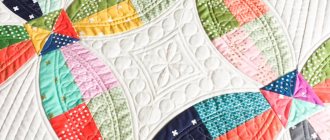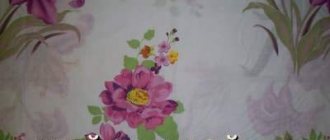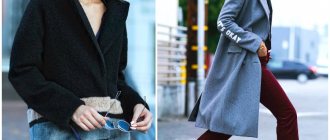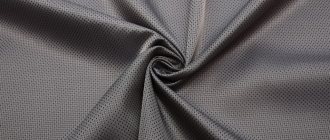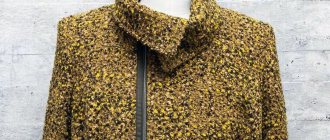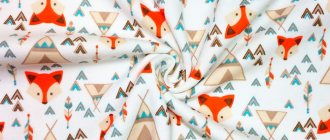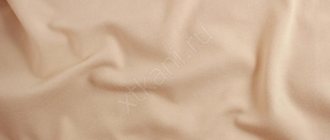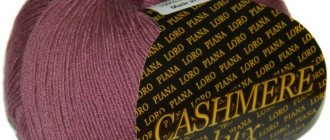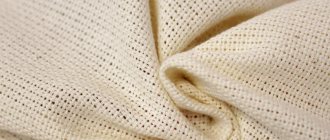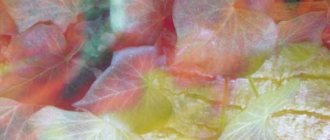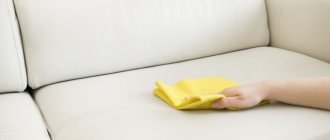Cotton is a natural fiber obtained from the cotton plant. It serves as the basis for the production of various types of materials from which clothes are sewn, interior and household items are made. This is the most important fiber for the textile industry - it is included in 55-60% of all fabrics produced in the world. Due to its characteristics and practicality, cotton fabrics have become widespread.
History of cotton
Cotton fabric is one of the first linen products on Earth. Man began cultivating cotton about 15,000 years ago. The first descriptions of the plant are found in Indian writings, where the material was highly valued along with decorations. Today, products from Egypt dating back more than 5,000 years have been preserved, confirming the strength of natural fibers.
Breathable structure of beautiful cotton fabric
Cotton fabric came to Europe already in the 1st century AD. e., the material was highly valued, and cotton began to be grown in many regions. Fabric appeared on Slavic lands in the 15th century, but since then it has taken one of the main positions, and in the 20th century. already accounted for ¾ of the total textile production. Today, a third of the world's cotton consumption comes from China, and the main suppliers are the United States and African countries.
The birthplace of cotton fabric
Asia Minor is considered the natural habitat of cotton and its homeland, and it was there that the plants began to be processed, creating soft white fabric. With merchants, cotton came to North African countries, Greece and the Mediterranean. There they highly appreciated the properties of the durable lightweight material and began to master the cultivation and processing of plant materials.
In China, cotton was grown for decorative purposes.
Initially, cotton was not dyed or bleached. Only high-ranking persons could afford bright outfits painted with expensive dyes. Indigo, a deep purple extract also coming from the Arabian Peninsula, was considered the most valuable. Much later, textile production began to gain momentum and spread throughout the world, offering more and more new solutions.
Composition and structure
Classic cotton fabric consists of 100% natural cotton, but modern production allows you to mix different types of raw materials, insulating, adding elasticity to the material and reducing the cost of the finished product. Typically, cotton is combined with other organic fibers - linen, wool, or with synthetics - acrylic, viscose, polyester and other fibers.
This is interesting! At first glance, the strange name of the fabric is associated with the smell of its fibers. When burned, cotton emits a papery aroma, similar to dry wood, which gave rise to the common name for the material.
Cotton is highly durable, hygroscopic and hypoallergenic, can be easily dyed and is very convenient to sew - it does not slip, washes and irons well. Thanks to these characteristics, the material remains popular and in demand to this day, and the variety of its varieties continues to grow.
You might be interested in what poplin fabric is made of: characteristics and features of the material
Unprocessed plant fibers
Composition of cotton fabrics
This parameter depends on what fibers were used to produce the material. It can be made from 100% pure cotton, or it can also contain chemical or synthetic fibers. Here's what these additives might be:
- viscose;
- linen;
- polyester;
- acetate;
- acrylic.
Each of the cotton fabrics has its own properties and characteristics. This depends not only on the composition, but also on additional processing, for example, mercerization of the material, the type of weave of the threads.
Production technology: stages
Fine cotton fibers are obtained from the seed pods of the plant. First, they are collected by hand or by machine, arranged in large fluffy bundles and sent to production. These clods are called raw cotton. It can be white, milky or pinkish.
Next, the cotton is cleaned of seed, seeds, and husks, sorted according to the length of the fibers - and twisted into solid continuous threads, producing yarn. All types of fabrics are woven from it.
Pure cotton has its own charm
In some cases, the threads are bleached and pre-dyed, but more often the finished fabric is subjected to this treatment. It is bleached and then painted in different ways. For example, a printed print can be colorful and variegated, while monochrome coloring can be smooth and “boiled.”
The difference between cotton and other natural fabrics
It is quite difficult to distinguish cotton from other natural fabrics according to a single criterion, but pairwise comparison helps to formulate an idea of the material:
- Cotton absorbs light, while silk, linen and even wool have a slight natural shine.
- Cotton is soft but warm, while silk creates a cooling effect and wool provides intense warmth.
- Cotton is the most breathable of all fabrics; it easily allows air to pass through, absorbs body moisture, and dries fairly quickly in the sun.
- Smooth, thin cotton fibers are evenly dyed, which is why so many types of fabric can be easily created from them.
Linen canvas is similar to cotton
How to distinguish linen fabric from cotton
There are several visual signs of how to distinguish thick cotton fabric from linen:
- Cotton is obtained from the soft fibers of the boll of the plant; it is similar to cotton wool, so the material is soft and delicate to the touch. Linen is made from the stems of the plant, so the linen is rough, uneven and slightly embossed.
- The color of natural cotton is pure white with possible shades, and undyed linen fabric is similar to straw - it has a grayish color with a golden or brown tint. At the same time, pure cotton has a matte tint, and linen has a characteristic tint.
- Despite the strength of cotton, it is still delicate and over time the threads can burst and break. Linen products last for decades without wearing out and keep their shape perfectly. At the same time, sewing from such fabric is quite difficult.
Rough linen material
Please note! The surest way to check is by touch: flax will be stiffer. Visually, its fibers are thicker, flatter, creating a feeling of pressing.
Properties of plain-dyed fabrics
Main characteristics of plain-dyed fabrics:
- variety of colors;
- matching the shade and purpose of the canvas;
- compatibility with other products.
On a note
When handled correctly, products made from plain-dyed fabric can withstand up to 500 washes without losing color.
The common advantage of all plain-dyed fabrics is color uniformity, which only means a visual effect. Their aesthetic properties are not as high as those of variegated or printed materials. Other consumer qualities depend on the nature of the fiber and the method of weaving: the pile texture gives the products softness, the smooth surface gives shine or dullness, the rough surface gives warmth and wear resistance.
Atlas
Smooth fabric, glossy on the front side. Wear-resistant, drapes well, retains its shape. Susceptibility depends on the composition: material based on silk threads is “afraid” of high temperatures, while semi-synthetic material is more resistant to heat.
Velvet
Luxurious pile fabric that requires special handling. The composition may contain wool, cotton or silk. By adding viscose, the material becomes stronger and more elastic. Velvet is painted in rich, iridescent shades. Thanks to the long pile, the surface is soft and warm. Negative properties include the need for delicate care: hand washing, careful removal of stains.
Velveteen
Corduroy contains natural and artificial fibers: cotton, polyester, elastane. A characteristic feature of the material is the vertical scars formed when laying the pile. Plain-dyed corduroy is very durable, wear-resistant, and easy to clean. Synthetic additives allow it to be elastic and simplify care. Corduroy products accumulate static electricity, so they attract debris, wool and dust.
Viscose
Thin fabric resembling cotton. Delicate, light, airy. Absorbs pigment freely and is easily painted in various shades. Hygroscopic material has the ability to allow moisture and air to pass through. Clothes made of viscose are comfortable for everyday wear and durable.
Cotton
100% cotton. Hypoallergenic material with good absorbency and air permeability. The rich color of plain-dyed cotton fades over time, especially with frequent washing or exposure to sunlight.
Linen
Material made from natural raw materials - flax fibers. The canvas is smooth, with a matte surface. Retains density for a long time, even with intensive use. It has the ability to shrink and wrinkles easily. Recommended washing in warm water.
Organza
Lightweight but stiff fabric made from silk, viscose and polyester. Can be shiny or matte. Doesn't stretch, keeps its shape. The material is transparent, used for sewing curtains, dance costumes, and finishing dresses.
Poplin
Dense cotton material with addition of synthetic threads. Soft, easily breathable, does not require ironing. Plainly dyed poplin does not fade or stretch - that is, it is a practical fabric, wear-resistant and durable.
tiar
Suit material with a smooth surface. It is created on the basis of polyester with the addition of wool and viscose, making the tiara softer and warmer. Due to the elastane threads, it stretches slightly, but retains its shape. The tiara is painted in classic solid colors: blue, black, gray.
Silk
Natural fabric made from silkworm threads. Manufactured using sophisticated technology. It has a smooth, shiny, cool surface. Conducts air and moisture, dries quickly. Doesn't fade after washing and holds pigment well.
Types of fabrics and their characteristics
Cotton fabric is made from cotton fibers - hollow, oblong structures that are spun into thread. Three types are used in production:
- Short ones - from 20 mm, they produce “loose” types of fabric with a heterogeneous structure, like flannel. They stretch, create an air cushion and provide warmth in cold weather. Over time, their surface rolls off.
- Medium - about 30 mm. This thread produces light summer fabrics that are distinguished by good “breathing” and hygroscopicity.
- Long - up to 50 mm in length, thanks to this the fabric is smooth and very durable. Such products do not lose their shape for a long time, maintaining their neatness and impressive appearance.
Delicate flannelette
It is also necessary to note that among the types of cotton fabrics there are natural and mixed ones. Acrylic, polyester and other fibers are added to natural fibers to increase the elasticity of the material, and cotton is mixed with wool to insulate the fabric.
You might be interested in this Characteristics and features of satin fabric: products made from the material
Smooth and sophisticated dressy cotton for dresses and blouses
Varieties
Plain-dyed fabrics are classified according to the type of raw material:
- cotton (calico, satin, flannel);
- linen;
- silk;
- woolen.
Smooth dyeing technology is used for natural, as well as artificial and synthetic materials: polyester, viscose, microfiber.
By application:
- linen;
- suit and dress;
- furniture and decorative;
- special;
- lining;
- raincoats;
- technical.
Types of weaves of cotton fabric
Cotton material is woven with different types of fiber weave. There are three main options:
- Linen is a classic look, where the threads are woven sequentially and form a smooth, even surface. This fabric is durable and effective. Examples of linen cotton include calico, poplin, chintz, and cambric.
- Satin - shiny fabrics with weft threads on the surface. Such materials look festive and sophisticated. In addition to the satin itself, these include, for example, an eraser.
- Twill is a rough, durable and slightly loose fabric with offset threads. Among them are flannel, denim, and tartan.
How threads are intertwined in cotton fabrics
All these types of weft and warp weave produce very diverse types of natural cotton fabric, and even within one of them there are very different varieties. Each fabric finds its specific application in the sewing and textile industry.
Twill weave
Twill weave materials are characterized by increased strength, durability and pleasant softness. As a rule, they are used to make not only clothes - jeans, jackets, jackets - but also furniture upholstery, drapery, and linings.
Characteristic color of denim
One of the most popular varieties was denim, which eventually gave birth to the beloved jeans. In the first case, fabric with a characteristic “ribbed” pattern is dyed in any shade, but jeans are a specific type. This option is not dyed a second time, but the fabric is woven from pre-dyed threads. The classic representation of denim includes all shades of indigo, but grey, green and other shades have long been produced.
The second type - flannel - is a soft fabric with a light brush on one or both sides. As a rule, homemade and comfortable everyday clothes are sewn from it, and sometimes thin blankets.
Bumazea is a smooth, warm material with one-sided brushing. It is also used to decorate home textiles, because such cotton (tufted) gives warmth, softens surfaces and looks impressive.
Scottish fabric
Tartan is “that” well-known dense and representative checkered cotton fabric. From which traditional kilts, suits, skirts and other products are sewn.
Price overview
What is the price? You can purchase cotton fabric at minimal cost, because its cost is low. Everything in this case determines the quality of the canvas and its appearance:
- Cotton dress and blouse – 1240 rubles.
- Costume and dress cotton - 1740 rubles.
- Shirt cotton – 980 rubles.
- Batiste – 890 rubles per linear meter
Cotton fabric is the most popular type of fabric for sewing comfortable and easy-to-wear products. The presented material is very widely in demand in the field of sewing linen, children's and adult clothing. In addition to its unique ability to allow air to pass through, this material is affordable due to its low cost.
Find out also about mixed fabrics for workwear in this article.
Types of cotton fabrics by finishing method
To improve the useful and aesthetic qualities of the material, it is processed in several ways, depending on what kind of cotton fabric it is. The preparatory stage means a lot: special impregnation makes the fibers more durable, durable and impressive in appearance.
- Severe fabrics are those that cannot be processed in any way.
- Bleached cotton is used in linen production, when dyeing fabrics in light and bright shades.
- Mercerized fabric is used for blouses, shirts and dresses, since the process allows the products not to shrink after washing and to better absorb moisture.
- Insulated fabrics are decorated with pile - flannel, fleece, flannel, terry.
- According to the method of dyeing, cotton can be plain-dyed - by soaking, printed - that is, with a pattern stamp, variegated - including multi-colored threads.
You may be interested in: Use of waffle fabric: what is sewn from it
Modern fabrics are decorated with stylish prints for all occasions
What kind of fabric is called plain dyed?
Plain-dyed fabric - what kind of fabric is it, what technology is it used to produce? Textile fabric can be natural, artificial and mixed. All fabrics, regardless of fiber composition, are divided into five main types according to color processing:
- bleached - obtained from harsh grain using a bleaching agent;
- plain-dyed – one-color;
- printed – a color pattern or print is printed on the surface;
- variegated - striped or checkered;
- melange - with colored specks.
Plain-dyed fabric is a homogeneous fabric whose front surface and back are the same color. There are no drawings on it, unlike printed materials. This effect is achieved due to the coloring method: instead of stencils, the full immersion method is used. This type of staining is simpler than other types of finishing. It is used for cotton, wool, and silk fabrics.
What can be sewn from cotton fabric
Cotton is universal, so you can sew any product from it - from simple pillowcases to a three-piece suit. Most often, summer dresses and trouser suits, medical or other special uniforms, and shirts are sewn from cotton.
Making a set of bed linen or beautiful curtains is also not a problem. There is no need to agree to compromises and overpay for branded products - you can buy material with your favorite premium or economical print and bring your unique ideas to life.
Caring for a cotton product
Cotton is not too demanding to care for, but it makes things last longer. Basic recommendations should be followed:
- To prevent items from shrinking, wash them at temperatures up to 60°C, but do not treat colored items with bleach.
- Dry the cotton, carefully straightening it, on hangers or mesh so that creases do not form that are difficult to smooth out.
- The iron temperature should not exceed 200°C, while cotton is ironed with steaming so that the fabric does not catch fire, is not sealed and looks soft.
- It is better to wash things made of cotton separately from synthetics and other fibers, then the surfaces will not wear out or become worn.
Cotton items are easy to wash and iron
. Important! If stains appear, they should be washed immediately in cool water, and then with soap in warm water, until the coloring pigments (wine, coffee, ink) are absorbed deeply into the fibers.
Cotton fabric must be ironed after washing to give things a neat look.
How is plain dyed fabric produced?
- The fabric removed from the loom is placed in a tank containing dye.
- Keep in container for 10 – 20 hours.
- At the end of the exposure time, the fabric is washed to remove excess dye.
On a note
Each type of fiber has its own dyeing temperature: for linen, processing at 90 ºC is suitable, for cotton – no more than 75 ºC. Wool requires delicate handling: only 50 ºC.
Fabrics can be dyed with the finished fabric, but there is another production technology: colored threads of the same shade, pre-dyed, are supplied to the machine. They have durable coloring and a more even tone over the entire surface. When the product is abraded, the color in damaged areas changes little.
Advantages and disadvantages of cotton
Despite the huge variety of cotton fabrics, they all share the positive properties of the fibers and some disadvantages. Among the obvious advantages are the following:
- High hygroscopicity and respiration. Thanks to these qualities, cotton can be worn in hot weather.
- Durability and abrasion resistance. Most cotton materials do not wrinkle, do not fade for a long time, and are resistant to tension. Therefore, they last a long time while remaining neat.
- Ease of processing. Cotton reacts well to dyeing, is easy to cut and machine sew, and can be simply washed and ironed.
- Hypoallergenic and pleasant texture. The fabric does not cause irritation, does not rub the skin and is suitable even for children.
Luxurious Breathable Cotton
Notable Flaws:
- Cotton tends to wrinkle and wrinkle, making clothes difficult to fit exactly to your figure. When washed in hot water, the material may shrink.
- The fabric is not elastic.
- Natural and eco-friendly types are expensive.
Important! To solve these problems, extend the life of cotton items and create beautiful models, synthetic fibers are added to the material in an optimal ratio, which is why the products do not lose their positive properties and only benefit.
The advantages of such fabric
Let's look at the benefits of cotton fabrics.
- Excellent hygroscopicity . The big advantage of cotton fabrics is that they absorb moisture well. That is why they are widely used for sewing summer clothes, bed linen, towels and children's clothing.
- Air permeability . Cotton fabrics “breathe”. Cotton clothes are pleasant to wear; they will help out in any circumstances: in the summer heat, at home, and to create an office look.
- Durability . Cotton fabrics do not deform too much and behave well when washed and dried. The strength and stability of cotton fiber is enhanced by artificial additives. Cotton fabric is weak in stretching and shrinking. Cotton fabrics tolerate repeated washing, ironing and other care procedures quite well, without losing their characteristics for a long time.
- Cotton makes the product light . In addition, this lightness is often combined with the thinness of the product. It is thanks to these properties that bed linen, underwear, and children's clothing are so often made from cotton.
- Cotton fabrics are easy to process . They are easy to process when cutting and sewing, and are “pleasant to deal with.” The sections of the canvas do not crumble, which is very convenient when working. The fabrics are pleasant to the touch and evoke positive tactile sensations. The material looks aesthetically pleasing. If the cotton fabric is of a noble shade and dense, an outfit made from it can look very stylish and modern.
In the video, clothes made from cotton fabric:
